Telling Stories for the Senses
Using audio and a series of photos to create a digital story sometimes deepens the readers' experience and engagement with your piece.
What has always excited me about writing online is the ability to combine images and sound to deepen the reader’s experience. Sometimes it’s fun to put together a photo story — a single photo with audio and narrative — or a digital story — multiple images, sound and narrative in video format.
I don’t see a lot of digital stories on Substack. Maybe we can change that. I’m hoping I can encourage you to try them out.
A digital story is different than a video. Even though you create a “video” with your slideshow and sound, using still images draws your reader in, allows them to spend time studying the photo as they listen and as a result it becomes active participation.
A straight video is a passive experience; the reader just watches, can’t study an image closely so let their brain float along for the ride.
When I set out to create a digital story — an external, journalistic story — I try to go to place where I’m comfortable wandering around and talking with strangers and where there’s a lot going on — a public gathering or event.
Agricultural fairs are photolicious. So much to shoot.
A few years ago, when my partner was away, I gifted myself a full day of capturing images and sound at The World’s Fair in Tunbridge, VT.
I arrived an hour after opening — the sun finally poking over the mountains on a warm, promising fall day. I left the fair 12 hours later, a few minutes before closing, just as teens and their dates climbed down from the rides and shuffled out to the field and their cars hoping that maybe, just maybe, they can make out a little before they have to drive home.
Everyone is in a good mood at a fair. They’ve come to have fun, to eat food they shouldn’t, spin their brains around in gravity defying rides, see things they haven’t ever seen or glimpse a way of life they miss and once lived when their bodies were younger and more fit.
Even the young girls and young boys all dressed in white, some with clip-on ties, are having fun, even in the Show Barn as they struggle with a recalcitrant heifer or lamb and try to keep it in line without the judges seeing. Spoiler alert: They do.
In the morning I wandered, taking advantage of the light and the smaller crowds. Towards midday I moved closer, first taking pictures of feet and then hands and, finally, faces. (It was here that I found the man who told me he no longer had cows at the fair because he’d sold them all after his son died. It was the response that set me back on track to writing my novel.
Here are some of the other sights of the day:

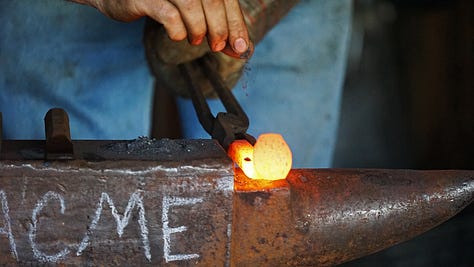
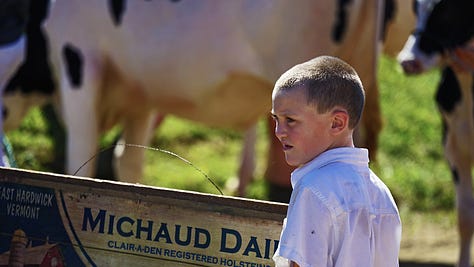
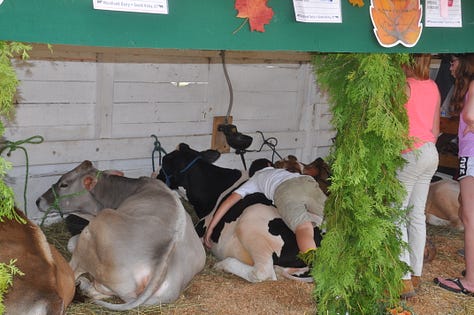
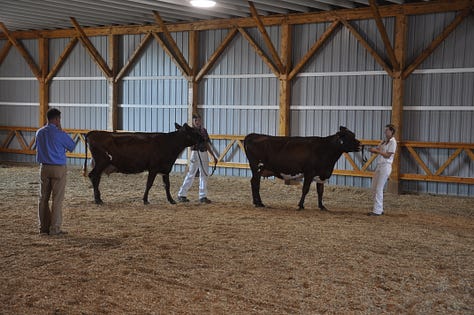

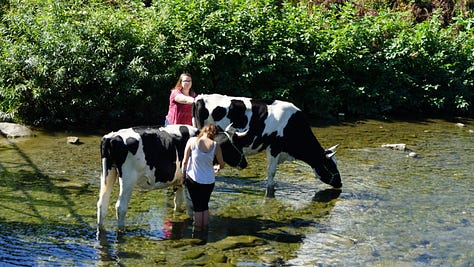
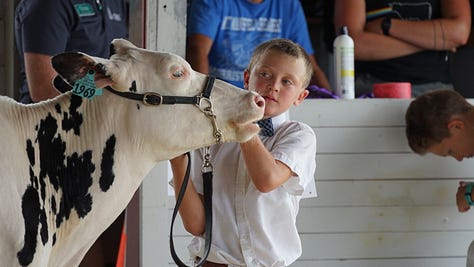
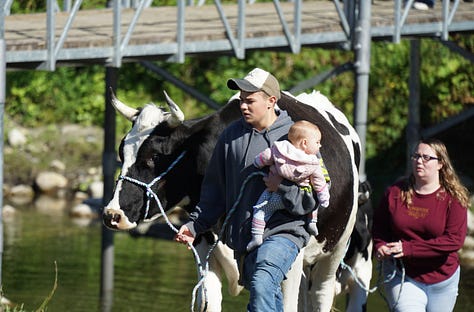
I particularly enjoy watching and listening to the horse and oxen pulls, where teams of animals pull stacks of cement blocks (each weighing 500 pounds) loaded on a sled. They get three tries to pull the sled 10 feet and if they don’t, they’re eliminated. The last team to successfully pull the load wins a generous cash prize, generous being a loosely used term.
To some pulling that kind of weight may seem a cruel exercise — to make the animals pull until they can’t anymore — but it’s not. The handlers treat them well. And the teams are trained for this — that’s all they do — or they’re just working out for the big game, winter skidding of logs, say.
I was still unsure of the story of the fair, even as rattling around my mind was the statement of that man, that older farmer who said only he sold ‘em all. Son dead. Not farming anymore.
All day I thought of it, trying to fill in the gaps of what happened, what now? A story was coming to me.
But how to tell this story, the story of the fair?
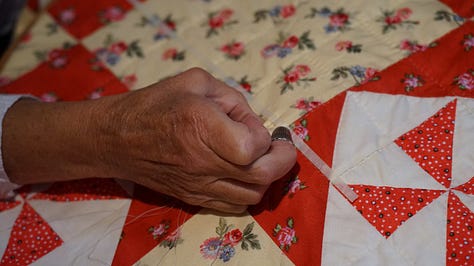
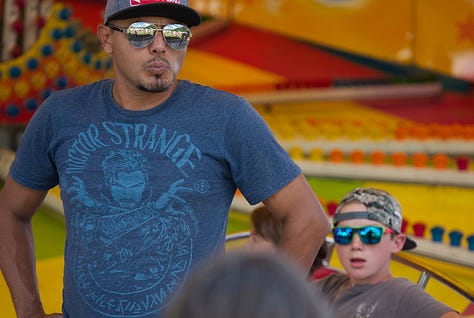
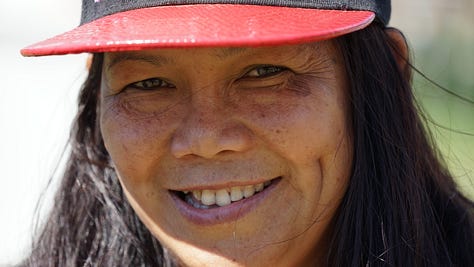

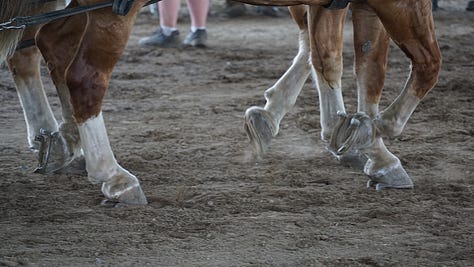


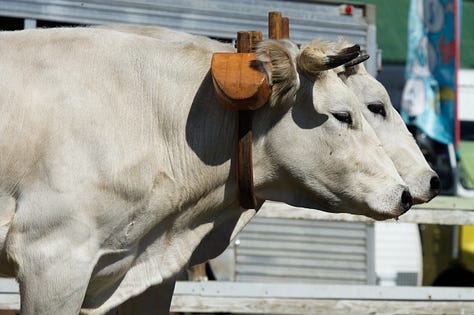

I had so many good photos, so much interesting sound. Then Brian Patten and his wife came into the Pulling Barn with their beautiful team of white oxen. I’ve watched the Pattens lead teams of oxen in pulling contests for nearly two decades.
What is distinctive about them is how they treat their oxen. His switches are more sound than bite. She whispers. He is patient with them, waits for them, encourages them. She lines them up to hook on the sled and hardly ever misses. And every time I’ve seen their team unable to pull a weight on the first try — unless there was a mix-up in hooking onto the sled — they would withdraw.
I asked him why. “If they don’t pull it the first time, that’s it. I don’t want to get them discouraged.” Decent. And it may be one reason his teams usually win.
I was going to include some of his voice, or, perhaps, let him tell the story, but they were done for the day and had to get home to New Hampshire. So I used ambient sound. Perfect really, just listening and looking in on the pictures, imagining yourself there, in the barn.
Here it is:
This works for me. What do you think?
And for those of you interested in this genre of storytelling, give it a try. I’ll be doing workshops in the spring, but here are some tips to get your started and feel free to reach out to me in the chat if you have questions.
Steps to a Digital Story
Go to a place you love to visit.
I’m sure you have places you love to visit or experience or watch things in action. Or, perhaps, these are places where you most feel like you. For me, it’s got to be a place where I can meet strangers, where I can meet new people, ask them lots of questions and experience them in settings where they are comfortable and we can chat. Events are nice. But so, too, is visiting a blacksmith or a local tailor or someone who owns a store. Tell them you just want to learn more about them, about their lives, about why they do what they do. Tell them you might do a story on them. Would they mind?
Nine times out of ten they don’t.
Take a camera.
A smartphone will do, but I find a quality digital camera puts me in a very different frame of mind. Photography requires a different part of my brain; it makes me look for details. And while details are what drive stories and good writing, photographs sometimes takes care of showing some of those details more powerfully than words.
Taking photographs does something else: It helps me figure out how to make the subject feel at ease. Most people get nervous around a camera or audio recorder. So the trick becomes making them feel comfortable, making them forget that I’m taking their picture. I talk to them. Tell them something funny or revealing. I commiserate. Empathize. Connect.
Ask questions.
I used to joke that journalism was a perfect occupation for me because I am so nosy. But the fact is I’m curious and my questions help me get deep into someone before they even know it. I always identify myself and tell them I am writing a story for my website. Do they mind if I did a story on them? They’re flattered, affirmed to be asked.
Record sound.
I have a huge, chaotic library of miscellaneous sounds that I’ve recorded over the years, from subway doors closing to thunderstorms, kids laughing at a set of swings to the sound of cows herding into a field. As you can tell, I live in the country. But I love to record things I’ve never heard before.
Ambient sound, as it’s called, can be extremely useful. make sure you capture the sound of the environment around the subject. And, make sure you record the person. (As best you can make sure there’s not a lot of background noise when you are interviewing; but I’ll get into that in a future column.)
Take a notebook.
Mine fits in my back pocket. I take two pens. At some point, I hand the notebook and pen to the person I’m interviewing and have them jot their names and contact info. I do that, I tell them, because that way I’m sure I’ve got the spelling correct.
I also offer folks free copies of my best photos for them to use however they’d like. I also jot down snippets of the conversation, questions that come up, conversations I overhear, things people tell me, ideas. Whatever. Some of it goes nowhere. Some of it leads to other stories. All of it helps me find the right sound file.
So try it out
Take a camera. (I use a Sony A7 ii). If you are using a smartphone, make sure it is set to take the largest and highest resolution photos possible. (I use an iPhone and use the ProCam app. It’s a bit complicated but works well.)
Two tips for the smartphone: 1) set the exposure down a stop or two (gives you greater depth) and 2) try to avoid the telephoto since that tends to degrade the actual photo.
Take a digital recorder or download an audio app for your phone. (I have an iPhone; I use Voice Record Pro 7 which is terrific and, particularly with an external mic that can give you great quality, or JustPressRecord if I also want a transcript.
Use a program or app to combine the photos and audio into a movie. (I use Soundslides (dirt easy and inexpensive) or WeVideo but there are many other programs to use.)
Choose a favorite place to catch humans (and/or animals) in motion. Go make a digital story.
Share it on Substack and share the link so we can see/hear it!




Well written engaging story, Geoffrey. Thanks for all the suggestions
Thanks for sharing these techniques, Geoffrey. I will definitely have to try them. Your article also brought back childhood memories of growing up on a ranch in Montana and attending county and state fairs.
But one thing frustrates me in regard to pictures on Substack, and I wonder if you have any solution?
I read your article last night on my phone as I was going to bed and clicked on the different pictures. But they were so small they didn't impress me that much. Just now, I opened them up on my computer, and they were absolutely wonderful!
What can we do about that? Suggest that people read our Substack newsletters on a computer (for articles in which the pictures are really important)? Or just hope for the best?